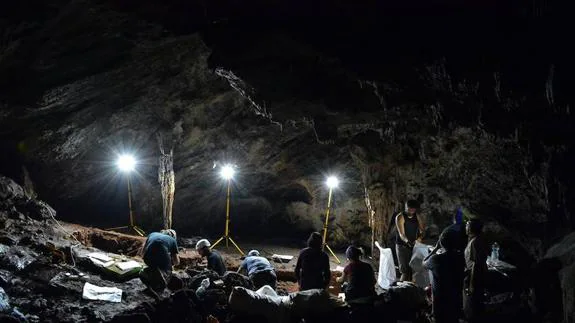The secrets buried in Ardales
The cave has revealed new information about the Neanderthal civilisations over 80,000 years ago
Fernano TOrres
Viernes, 22 de septiembre 2017, 12:14
The prehistoric cave of Ardales continues to uncover secrets which have spent thousands of years hidden underground, nearly a century after the first archaeologists went to investigate. An investigation team made up of Spanish and German academics and experts have been working on site, and also at the Sima de las Palomas in nearby Teba, since the start of September and were able to share their important findings after just under two weeks of digging.
Some findings have opened up new ideas about the archaeological remains buried there, while others support the theories unearthed after excavations in 2016. José Ramos, professor at Cádiz university and director of the study, explained that they have been studying Neanderthal beings from over 80,000 years ago.
These results pose an interesting addition to the debate about the end of the period of Neanderthal civilisations. It is unlikely that these beings lived at the same time as modern man, and, as far as we can see, there was a gap of several thousand years between the disappearance of the first men and the arrival of our ancestors.
Currently, they are researching different characteristics of modern humankind. The study has revealed the ways in which the coast and the land worked for humankind in the past. They have discovered that the caves were used as temporary shelter for hunting but the same civilisations also used the coastline for fishing. Previously, scientists had thought of the people of this era as land hunters and gatherers. To advance these discoveries and have a more precise dating, the investigators studied Paleolithic technology and shells.
Pedro Cantalejo, natural heritage coordinator and historian of the Guadalteba area of Malaga province, says that studying rocks and the way civilisations worked with them is vital in understanding the cave and its past. Every civilisation engraved flint in their own way, always in different ways to their predecessors and their successors.
According to Cantalejo it is very rare for the Paleolithic period to be so well recorded, from oldest to most recent in the same site. The scientist explained that the research into human presence over the last 80,000 years is still in its preliminary phases.
Dating their findings can be much more precise with modern technology and has allowed archaeologists to study the sites of Ardales and Teba more. Previously, they had considered the best sites to be in Nerja.
Moreover, the Max Planck Institute in Germany, one of the most prestigious institutes for genetic analysis, is interested by the 16 human remains that there are on the site. When we have studied the DNAwe will know the exact origin of the people buried here. This will change the way in which we see everything, Cantalejo claims.
The project is funded by Unicaja and Ardales and Teba councils. It shares its objectives with Cadiz University and the Colognes Neanderthal Museum.
In total, more than 60 investigators from 28 institutes, museums, universities and investigative centres in Spain, Germany, England and France are participating. Gerd C. Weniger, from the Colognes Neanderthal Museum is leading the investigation, in conjunction with doctor José Ramos.
